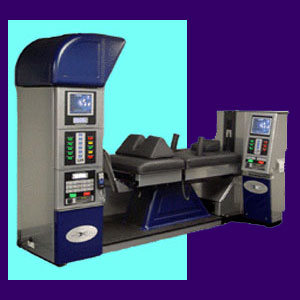
DRX 9000 is a high-tech machine that uses spinal decompression to treat a variety of potentially symptomatic back and neck conditions. The system is manufactured by Axiom Worldwide and has received FDA approval for treatment of certain types of back pain.
This version of the spinal decompression procedure uses a modern computer controlled version of traction to slowly and gently pull the spine in an attempt to enlarge the intervertebral disc and neuroforaminal spaces. The machine represents the state of the art in non-invasive, non-surgical back pain treatment.
DRX therapy remains controversial, since there have been some scandals in the supportive research citations and an overall lack of definitive evidence showing that it actually does what it claims to do. However, patients generally speak highly of the treatment, which does say volumes about its potential efficacy.
Meanwhile the most outspoken critics are traditional spinal surgeons. I wonder if their outrage has anything at all to do with the huge number of patients who no longer undergo back surgery after successful DRX9000 treatment. The economics of medicine are never far out of focus.
DRX 9000 Uses
The DRX machine is most often used to treat herniated discs and degenerative disc disease. It is also sometimes indicated for some causes of sciatica and posterior facet syndrome.
The process of spinal decompression literally pulls the spinal vertebrae apart to remove pressure on discs, nerves and bones. This procedure is done slowly and gently to reduce any chance of additional injury.
The accuracy and precision of this computerized machine is extraordinary and the programming technician can set incredibly specific parameters to define the area to be treated. Although I have seen DRX used to treat idiopathic and nonspecific forms of back and neck pain, this is far riskier and typically less effective than if the patient has achieved a rock solid and correct diagnosis as to the exact source of pain.
Spinal Decompression Program
DRX patients will usually visit the treatment center every day for 2 weeks. After the initial daily treatments, the patient will continue to receive treatment 3 times a week for 2 to 3 weeks on average. Each session is 30 to 45 minutes long and most patients do not report feeling any discomfort during decompression treatment.
Some DRX centers use hydrotherapy or heat to relax the back muscles prior to treatment. After treatment, ice therapy via a cold gel pack is employed to help set the muscles in place. Many doctors also use electrotherapy in the form of TENS, to reinforce treatment after decompression.
DRX is usually a finite treatment regimen with most patients not needing to undergo follow up care. However, given a symptomatic recurrence, follow-up sessions can be used to reintroduce the treatment as required.
DRX 9000 Results
75% to 86% of patients report positive results using spinal decompression. The results are better for herniated disc injuries than for any other condition. Facet syndrome results are the lowest for spinal decompression, but 75% is still an impressive figure. The long-term curative statistics are less verifiable, since the treatment is relatively new ( FDA approved in 2001 for lumbar, 2002 for cervical).
Critics of DRX call it everything from a placebo to a scam to a danger. I have heard all manner of opinions of the system, provided by patients and caregivers alike. It is for this reason that I recommend that all patients who are interested in DRX care should thoroughly research the treatment and learn the facts for themselves before agreeing to undergo even a single session.
DRX 9000 Experiences
There are several different types of providers using DRX decompression machines. I would recommend choosing a provider with the most experience in this treatment, regardless of their specialty. Some medical doctors and physical therapists have integrated DRX into their practices, but it seems that chiropractors have been the profession which has endorsed decompression therapy the most.
Warning for elderly patients or those who might have osteoporosis: Spinal decompression can be dangerous for patients with compression fractures in the spine. Make sure that you have been thoroughly screened for fractures before undergoing treatment. Not doing so can risk serious health consequences, such as worsening of the fracture or even enacting a state of spinal instability.
Decompression is also not usually indicated for patients who have undergone any type of spinal fusion surgery or corpectomy.





